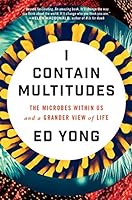
## Metadata
- Author: [[Ed Yong]]
- Full Title: I Contain Multitudes
- Category: #books
## Highlights
- Even now, the photosynthetic bacteria in the oceans produce the oxygen in half the breaths you take, and they lock away an equal amount of carbon dioxide. ([Location 362](https://readwise.io/to_kindle?action=open&asin=B01824YMCM&location=362))
- there are more bacteria in your gut than there are stars in our galaxy. ([Location 368](https://readwise.io/to_kindle?action=open&asin=B01824YMCM&location=368))
- As palaeontologist Andrew Knoll once said, “Animals might be evolution’s icing, but bacteria are really the cake.” ([Location 370](https://readwise.io/to_kindle?action=open&asin=B01824YMCM&location=370))
- For roughly the first 2.5 billion years of life on Earth, bacteria and archaea charted largely separate evolutionary courses. Then, on one fateful occasion, a bacterium somehow merged with an archaeon, losing its free-living existence and becoming entrapped forever within its new host. That is how many scientists believe eukaryotes came to be. It’s our creation story: two great domains of life merging to create a third, in the greatest symbiosis of all time. The archaeon provided the chassis of the eukaryotic cell while the bacterium eventually transformed into the mitochondria. ([Location 383](https://readwise.io/to_kindle?action=open&asin=B01824YMCM&location=383))
- The latest estimates suggest that we have around 30 trillion human cells and 39 trillion microbial ones – a roughly even split. ([Location 405](https://readwise.io/to_kindle?action=open&asin=B01824YMCM&location=405))
- Most microbes are not pathogens. They do not make us sick. There are fewer than 100 species of bacteria that cause infectious diseases in humans;8 by contrast, the thousands of species in our guts are mostly harmless. At worst, they are passengers or hitchhikers. At best, they are invaluable parts of our bodies: not takers of life but its guardians. They behave like a hidden organ, as important as a stomach or an eye but made of trillions of swarming individual cells rather than a single unified mass. ([Location 418](https://readwise.io/to_kindle?action=open&asin=B01824YMCM&location=418))
- The microbiome is infinitely more versatile than any of our familiar body parts. Your cells carry between 20,000 and 25,000 genes, but it is estimated that the microbes inside you wield around 500 times more.9 This genetic wealth, combined with their rapid evolution, makes them virtuosos of biochemistry, able to adapt to any possible challenge. They help to digest our food, releasing otherwise inaccessible nutrients. They produce vitamins and minerals that are missing from our diet. They break down toxins and hazardous chemicals. They protect us from disease by crowding out more dangerous microbes or killing them directly with antimicrobial chemicals. They produce substances that affect the way we smell. They are such an inevitable presence that we have outsourced surprising aspects of our lives to them. They guide the construction of our bodies, releasing molecules and signals that steer the growth of our organs. They educate our immune system, teaching it to tell friend from foe. They affect the development of the nervous system, and perhaps even influence our behaviour. ([Location 422](https://readwise.io/to_kindle?action=open&asin=B01824YMCM&location=422))
- Every organ is also variable in itself. The microbes that live at the start of the small intestine are very different from those in the rectum. Those in dental plaque vary above and below the gum-line. On the skin, microbes in the oily lakes of the face and chest differ from those in the hot and humid jungles of the groin and armpit, or those colonising the dry deserts of the forearms and palms. Speaking of palms, your right hand shares just a sixth of its microbial species with your left hand.19 The variations that exist between body parts dwarf those that exist between people. Put simply, the bacteria on your forearm are more similar to those on my forearm than to those in your mouth. ([Location 523](https://readwise.io/to_kindle?action=open&asin=B01824YMCM&location=523))
- surface or provide molecules that keep pathogens at bay. But Hadfield ([Location 1237](https://readwise.io/to_kindle?action=open&asin=B01824YMCM&location=1237))